Ko Plavix 75 mg / 100 mg 28’s film-coated tablets
$125.60
Description
The instruction for medical use
of medicine
To –
Plaviks Torgovoye nazvaniye Co-Plaviks
the International non-proprietary name
Is not present
the Dosage form
of the Tablet, film coated, 75 mg / 100 mg
Structure
One tablet contains
active agents: form II of 97.875 mg (it is equivalent to a klopidogrel to the basis – 75 mg)
acid atsetisalitsilovy, granulated with starch 111, 111 mg (is equivalent to acetylsalicylic acid – 100 mg),
excipients klopidogret hydrosulphate: Mannitolum, a macrogoal 6000, cellulose microcrystalline (with the low content of water, 90 mkg), hydroxypropyl cellulose the low-substituted, castor oil hydrogenated, stearic acid, silicon dioxide anhydrous colloidal,
structure of a cover: Опадри® pink 32K24375, wax Brazilian wax palm.
The description
Light pink, oval, slightly convex tablets, film coated, with an engraving of C75 on one party and A100 on other party
Pharmacotherapeutic group
Inhibitors of aggregation of thrombocytes
the ATX B01AC Code
klopidogret the Pharmacological Klopidogrel Vsasyvaniye Pharmacokinetics properties After single and repeated oral doses of 75 mg a day quickly was soaked up. It was noted average peak plasma concentration of not changed klopidogrel (about 2.2-2.5 ng/ml after single dose of an oral dose of 75 mg) approximately in 45 minutes after reception. On the basis of the metabolites of a klopidogrel allocated with urine the absorption is not less than 50%.
Distribution
Klopidogrel and the main, circulating in blood (inactive) metabolite enter reversible communication with proteins of in vitro plasma (98% and 94%, respectively). In the conditions of in vitro the communication is not saturable in the wide range of concentration.
Biotransformation
Klopidogrel is substantially metabolized in a liver. In vitro and in vivo klopidogret is metabolized in two main ways: one is mediated by esterases and leads to hydrolysis with education inactive derivative carboxylic acid (85% of the circulating metabolites), another is mediated by multiple isoenzymes of P450 cytochrome. At first klopidogret it is metabolized up to 2-oxo-klopidogrela, being an intermediate metabolite. The subsequent metabolism of an intermediate metabolite 2-oxo-klopidogrela leads to formation of an active metabolite of a klopidogrel, thiol derivative klopidogrel. In vitro metabolism on this way is carried out with the participation of isoenzymes of CYP3A4, CYP2C19, CYP1A2 and CYP2B6. An active thiol metabolite which is isolated by in vitro quickly and it is irreversible contacts receptors of thrombocytes, suppressing thereby aggregation of thrombocytes.
Cmax of an active metabolite increases twice as after a single load dose of a klopidogrel of 300 mg, and after reception of a maintenance dose of 75 mg within 4 days. Cmax is observed approximately during from 30 to 60 minutes after reception.
Removal
After reception of a klopidogrel, marked – 14C, about 50% is removed with urine, about 46% with a stake within 120 hours after reception. After reception of single 75 mg of an oral dose the elimination half-life of a klopidogrel made about 6 hours. Elimination half-life of the main circulating (inactive) metabolite made 8 hours after single and repeated receptions.
A pharmacogenetics
of CYP2C19 it is involved in formation of both active metabolites and an intermediate metabolite 2-oxo-klopidogrela. The pharmacokinetics and antithrombocytic effects of an active metabolite of a klopidogrel as it was estimated in researches of aggregation of thrombocytes ex vivo, change depending on CYP2C19 genotype.
The allele of CYP2C19*1 corresponds to completely functional metabolism whereas alleles of CYP2C19*2 and CYP2C19*3 correspond to nonfunctional metabolism. Alleles of CYP2C19*2 and CYP2C19*3 cause the most part of alleles with reduced function at European (85%) and Asian (99%) slow metabolizator. Other alleles associated with the absent or reduced metabolism meet less often and include CYP2C19*4, * 5, * 6, * 7 and * 8. Patients with the status of a slow metabolizator will have carriage of two alleles with defunctionalization as it was mentioned above. The published frequency for CYP2C19 of genotypes of slow metabolizator is about 2% for Europeans, 4% of the African race and 14% of the Chinese origin. There are tests for definition of CYP2C19 of a genotype of the patient.
Special populations
the Pharmacokinetics of an active metabolite of a klopidogrel in these special populations is unknown.
The renal failure
After repeated 75 mg of doses of a klopidogrel a day the patient with a serious illness of kidneys (clearance of creatinine from 5 to 15 ml/min.), suppression of the aggregation of thrombocytes caused by ADF was lower (25%), than was observed at healthy subjects, however lengthening of a bleeding time was similar to what was observed at healthy, receiving 75 mg of a klopidogrel a day. Besides, all patients had a good clinical tolerance.
After repeated doses of a klopidogrel on 75 mg a day for 10 days the patients with a heavy abnormal liver function suppression of the aggregation of thrombocytes caused by ADF (adenosinediphosphate) had a similar abnormal liver function to what was observed at healthy subjects. Lengthening of average time of bleeding in both groups was similar too.
The race
Prevalence of alleles of CYP2C19 which consequence average and bad metabolism of CYP2C19 is changes depending on race / ethnic origin (see. Pharmacogenetics). For assessment of clinical consequences of influence of a genotype of this CYP for a clinical outcome of the phenomena in literature there are only limited data obtained on Asian populations.
Acetylsalicylic acid (ASK):
Absorption
After absorption of ASK, contained in Ko-Plaviksa, is hydrolyzed to salicylic acid, at the same time peak concentration of salicylic acid in plasma are measured in limits of 1 hour after introduction so in 1.5-3 hours after reception of ASK in plasma is practically not defined.
Distribution
of ASK badly contacts plasma proteins, the volume of distribution is small (10 l). Its metabolite, salicylic acid, very well contacts plasma proteins, but this communication depends on concentration (nonlinear). At low concentration (& lt, 100 µг/мл) about 90% of salicylic acid are connected with albumine. Salicylic acid is well distributed on all fabrics and liquids of an organism, including in the central nervous system, breast milk and fabrics of a fruit.
Biotransformation and removal
of ASK as a part of Ko-Plaviksa quickly is exposed to hydrolysis in blood plasma to salicylic acid with elimination half-life 0.3-0.4 hours for doses of ASK of 75-100 mg. Salicylic acid generally is exposed to conjugation in a liver with formation of salitsilurovy acid, phenolic and acylic glucuronides and also some other minor metabolites. Plasma elimination half-life of salicylic acid in Ko-Plaviksa makes about 2 hours. Metabolism of salicylate is saturable, its general clearance at high concentrations of salicylic acid in serum decreases because of limited ability of a liver to form salitsilurovy acid and a phenolic glucuronide. After reception of toxic doses of ASK (10-20 g) the increase in plasma elimination half-life is possible till 20 o’clock. At high doses of ASK the removal of salicylic acid corresponds to kinetics of a zero order (i.e. clearance rate is invariable in relation to plasma concentration) with elimination half-life of 6 o’clock and more. Removal by kidneys of invariable active agent depends from rn urine. At increase rn wet higher than 6.5 renal clearance of free salicylate increases with & lt, 5% to & gt, 80%. After therapeutic doses about 10% 75% – in the form of salitsilmochevy acid, 10% – phenolic and 5% – atsetilglyukuronid of salicylic acid are found in urine in the form of salicylic acid.
On the basis of pharmacokinetic and metabolic properties of both connections of clinically significant pharmacokinetic interactions it is not expected.
The pharmacodynamics
Klopidogrel, Ko-Plaviksa’s component, this pro-medicine, one of metabolites of which is inhibitor of aggregation of thrombocytes. Klopidogrel has to be metabolizirovan CYP450 enzymes that the active metabolite which suppresses aggregation of thrombocytes was formed. The active metabolite of a klopidogrel selectively suppresses linking of adenosinediphosphate (ADF) with the receptor of P2Y12 located on a thrombocyte and the subsequent, mediated by ADF activation of the glycoprotein GPIIb/IIIa complex, thereby suppressing aggregation of thrombocytes. Owing to irreversibility of the formed communication the affected thrombocytes are surprised for all remained period of the existence (about 7-10 days), restoration of normal function of thrombocytes happens to speed, the corresponding speed of updating of thrombocytes. The aggregation of thrombocytes caused by the agonists other than ADF is suppressed by blocking of distribution of the activation of thrombocytes caused by the released ADF too.
As the active metabolite is formed with the participation of CYP450 system enzymes some of which are polymorphic or are suppressed with other drugs, not at all patients the extent of oppression of thrombocytes is sufficient.
Pharmakodinamichesky effects
Repeated doses of a klopidogrel on 75 mg a day from the first day provided considerable suppression of the aggregation of thrombocytes caused by ADF, this effect progressively amplified and reached a stage of an equilibrium state between 3 and 7 days. In a stage of an equilibrium state the average degree of inhibition observed at a dose of 75 mg a day made from 40% to 60%. Aggregation of thrombocytes and a bleeding time gradually returned to initial level, as a rule, in 5 days after the treatment termination.
Acetylsalicylic acid suppresses aggregation of thrombocytes due to irreversible suppression of prostaglandinovy cyclooxygenase and, thus, suppresses formation of A2 thromboxane which is the inductor of aggregation of thrombocytes and vasoconstrictions. This effect remains throughout all life of a thrombocyte.
Data of pilot studies demonstrate that the ibuprofen at simultaneous use can suppress effect of low-dose aspirin on aggregation of thrombocytes. In one research at reception of a single dose of an ibuprofen of 400 mg within 8 hours to or in 30 minutes after intake of aspirin with fast release (81 mg) it was reported about decrease in effect of ASK on formation of thromboxane or aggregation of thrombocytes. However the limitation of these data and uncertainty concerning extrapolation of data of ex Vivo on a clinical situation mean lack of reliable conclusions about regular reception of an ibuprofen, and irregular reception of an ibuprofen, most likely, does not cause clinically significant effect.
Prevention of aterotrombotichesky events at the adult patients who are already receiving also klopidogret indications, and acetylsalicylic acid (ASK). To-Plaviks is the combined medicine with the fixed doses of the active agents entering it for therapy continuation:
– a sharp coronary syndrome without increase in a segment of ST (unstable stenocardia or a myocardial infarction without tooth Q), including patients to whom stenting after percutaneous coronary intervention
– an acute myocardial infarction with increase in a segment of ST at the patients who are on drug treatment and having an opportunity for performing thrombolytic therapy is carried out.
A route of administration and doses
the Dosage
– Adult and elderly patients
To-Plaviks it is necessary to accept in the form of a single daily dose 75 mg / 100 mg.
To-Plaviks it is used after an initiation of treatment klopidogrely and ASK which were accepted separately.
– Patients with a sharp coronary syndrome without raising of a segment have ST (unstable stenocardia or a myocardial infarction without tooth Q): the optimum duration of treatment is officially not established. Data of clinical trial testify in favor of its use up to 12 months, and the maximum positive effect was observed in 3 months (see. Pharmacodynamics). If Ko-Plaviksa’s use is stopped, for patients the continuation treatment by antithrombocytic medicine can be useful.
– At patients with an acute myocardial infarction, with raising of a segment of ST: after emergence of symptoms the therapy should be begun as soon as possible and to continue not less than four weeks. The positive effect of a combination of a klopidogrel with ASK after four weeks of treatment in this disease was not studied (see. Pharmacodynamics). If Ko-Plaviksa’s reception is stopped, patients can successfully continue treatment by one of antithrombocytic medicinal means.
If reception of one dose of drug is missed:
– and if there passed no more than 12 hours after the usual planned drug intake time, patients should accept immediately a dose and then to accept the following dose in the usual planned time
– but if there passed more than 12 hours: patients should accept the following dose in the usual planned time and it is not necessary to accept a double dose.
– Pediatric population
Safety and Ko-Plaviksa’s efficiency at children and teenagers is younger than 18 years are not established. This population is not recommended to accept To-Plaviks.
–
To-Plaviks patients with heavy disturbance of renal function should not accept disturbance of renal function (see. Contraindications). Experience on treatment of patients with easy and average extent of disturbance of renal function is limited (see. Special instructions) therefore To-Plaviks it has to be applied at these patients with care.
–
To-Plaviks patients cannot accept disturbance of hepatic function with a heavy abnormal liver function (see. Contraindications). Experience on treatment of patients with average degree of an abnormal liver function at whom hemorrhagic diathesis is possible, it is limited (see. Special instructions). Therefore To-Plaviks it has to be applied at these patients with care.
A method of administration
For intake.
To-Plaviks it is possible to accept in independence of meal.
By-effects
Bleeding is the most frequent undesirable reaction which was reported mainly, in the first month of treatment. The undesirable reactions arising at monotherapy klopidogrely, monotherapies of ASK, ASK combination with klopidogrely during clinical trials or reactions which were stated spontaneously, provided below. Their frequency is described with use of the following symbols: frequent (≥ 1/100 to & lt, 1/10), infrequent (≥ 1/1.000 to & lt, 1/100), rare (≥ 1/10.000 to & lt, 1/1.000), very rare (& lt, 1/10.000), it is unknown (it is impossible to define on the basis of the available data). In each class of systems of bodies the undesirable reactions are specified in decreasing order of their gravity.
Often
– a hematoma
– nasal bleeding
– gastrointestinal bleeding, diarrhea, an abdominal pain, dyspepsia
– hemorrhage in skin and hypodermic fabrics (bruises)
– bleeding from the place of a puncture
Infrequently
– thrombocytopenia, a leukopenia, an eosinophilia
– intracranial bleeding (in several cases it was reported about a lethal outcome), a headache, paresthesia, dizziness, intraocular hemorrhage (conjunctival, ocular, retinal)
– ulcer of stomach and a 12-perstny gut, gastritis, vomiting, nausea, a constipation, a meteorism
– rash, an itching, a purpura
– a hamaturia
– lengthening of a bleeding time, decrease in number of neutrophils, decrease in number of thrombocytes
Is rare
– a neutropenia, including a heavy neutropenia
– vertigo
– retroperitoneal bleeding
is Very rare
– the trombotichesky Werlhof’s disease (TWD) (see. Special instructions), aplastic anemia, a pancytopenia, an agranulocytosis, heavy thrombocytopenia, the acquired hemophilia And, a granulocytopenia, anemia
– a serum disease, anaphylactoid reactions
– hallucinations, confusion of consciousness
– disturbance of flavoring feelings
– heavy bleeding, bleeding from an operational wound
– a vasculitis, hypotension
– bleedings of a respiratory system (pneumorrhagia, pulmonary bleeding, a bronchospasm, an interstitial pneumonitis)
– eosinophilic pneumonia
– gastrointestinal and retroperitoneal bleeding with a lethal outcome, pancreatitis
– colitis (including ulcer or lymphocytic)
– stomatitis
– an acute liver failure, an aberration of functional trials of a liver
– bullous dermatitis (toxic epidermal necrolysis, Sti-vensa-Johnson’s syndrome, a mnogoformny erythema), a Quincke’s disease, the medicinal caused hypersensitivity syndrome, medicinal rash with an eosinophilia and system symptoms (DRESS), erythematic rash or exfoliative, urticaria, eczema, flat deprive
– skeletal and muscular bleeding (hemarthrosis), arthritis, arthralgias, myalgias
– a glomerulonephritis, increase in level of creatinine in blood
– fever
Frequency is unknown (from the published data on ASK)
– an acute anaphylaxis, cross-reaction of medicinal hypersensitivity between thienopyridines (for example, tiklopidin, prazugret) (see. Special instructions), strengthening of symptoms of food allergy
– a hypoglycemia, gout (see. Special instructions)
– a hearing loss or a ring in ears
– disturbances from an upper part of digestive tract (esophagitis, an ulcer esophagitis, perforation, erosive gastritis, an erosive duodenitis, a gastroduodenal peptic ulcer / perforation) a gastroduodenal ulcer / perforation, disturbances from a lower part of digestive tract (small [a small and ileal intestine] both big [thick and a rectum] intestines ulcers, colitis and perforation of intestines, symptoms from an upper part of digestive tract, such as gastralgia (see. Special instructions)
– not cardiogenic fluid lungs at prolonged use and in the conditions of hypersensitivity reaction owing to intake of acetylsalicylic acid
– such reactions from a GIT connected with reception of ASK can be followed or not be followed by bleeding and arise at any dosage of acetylsalicylic acid and also at the patients having or not having the warning symptoms or the serious phenomena from a GIT in the anamnesis
– damage of a liver, mainly hepatocellular, hepatitis, increase in enzymes of a liver,
– the acute disorder of renal function (especially at patients with the existing renal failure, a warm decompensation, a nephritic syndrome or the accompanying treatment with diuretics)
the Message of the suspected side reactions
Is important the message of the suspected side reactions after medicine registration. It allows to conduct continuous monitoring of balance of advantage/risk of medicine. Workers of health care are asked to report about any suspected side reactions through national reporting system.
Contraindications
Due to the presence of both components of medicine To-Plaviks it is contraindicated in the following cases:
– hypersensitivity to active agents or to any of excipients
– heavy disturbance of hepatic function
– acute pathological bleeding, for example, from a round ulcer or intracraneal hemorrhage
Besides, in connection with presence of ASK drug is contraindicated in the following cases:
– hypersensitivity to non-steroidal anti-inflammatory drugs (NPVS) and a syndrome of asthma, rhinitis and nasal polyps
– heavy disturbance of renal function
– the third trimester of pregnancy (see. Special instructions)
Medicinal interactions
Oral anticoagulants: combined use of Ko-Plaviksa with oral anticoagulants is not recommended as it can strengthen bleeding (see. Special instructions). Though reception of a klopidogrel in a dose of 75 mg a day did not influence pharmacokinetics of S-warfarin or INR (the international normalized relation) at the patients receiving long therapy by warfarin, the concomitant use of a klopidogrel with warfarin increases risk of bleeding because of independent effects on a hemostasis of both drugs.
IIb/IIIa glycoprotein inhibitors: To-Plaviks it is necessary to apply with care at the patients receiving at the same time IIb/IIIa glycoprotein inhibitors (see. Special instructions).
Heparin: in the clinical trials conducted with participation of healthy volunteers klopidogret did not cause need for change of a dose or change of effect of heparin on coagulation. Simultaneous use of heparin did not influence the suppression of aggregation of thrombocytes caused klopidogrely. Between Co-Plavix and heparin perhaps pharmakodinamichesky interaction leading to the increased risk of bleeding. Therefore, simultaneous use of these drugs demands care (see. Special instructions).
Thrombolytic means: safety of co-administration klopidogret, fibrin specific or fibrin of nonspecific thrombolytic means and heparins was estimated at patients with an acute myocardial infarction. Frequency of clinically significant bleedings was similar to that that it was observed at combined use of thrombolytic means and heparin with ASK (see. Side effects). Safety of reception of Co-Plaviksa along with other thrombolytic means is officially not established therefore it is necessary to show care (see. Special instructions).
NPVS (non-steroidal anti-inflammatory drugs): in the clinical trials conducted with participation of healthy volunteers, combined use of a klopidogrel and Naproxenum increased the latent losses of blood through a GIT. Therefore, the concomitant use of NPVS, including TsOG-2 inhibitors, is not recommended (see. Special instructions).
Experimental data demonstrate that the ibuprofen can suppress the effect of a low dose of aspirin rendered on aggregation of thrombocytes when they are applied at the same time. Nevertheless, the limitation of these data and uncertainty concerning extrapolation of data of ex Vivo on a clinical situation mean what cannot be made reliable conclusions concerning regular use of an ibuprofen therefore incidental use of an ibuprofen is considered clinically not significant (see. Pharmacodynamics).
SIOZ (selective serotonin reuptake inhibitors): as SIOZ influence activation of thrombocytes and increase risk of bleedings their joint appointment with klopidogrely demands care.
Another simultaneous with klopidogrely therapy: as klopidogret it is metabolized to the active metabolite partly thanks to CYP2C19, use of medicines which suppress activity of this enzyme will result, as expected, in reduced concentration of an active metabolite of a klopidogrel. The clinical importance of this interaction is precisely unknown. For precaution, it is not necessary to approve simultaneous use of strong or moderate CYP2C19 of inhibitors (see. Special instructions and Pharmacological properties).
Omeprazolum and esomeprazole, fluvoksamin, fluoxetine, moklobemid, vorikonazol, flukonazol, tiklopidin, ciprofloxacin, Cimetidinum, carbamazepine, okskarbazepin and chloramphenicol belong to medicines which suppress CYP2C19.
Inhibitors of a protonew pomp: purpose of 80 mg of omeprazolum once a day in one and too time with klopidogrely or with the 12th hour interval between prescribing of two medicines reduced duration of action of an active metabolite by 45% (load dose) and 40% (maintenance dose). Decrease was connected from 39% (load dose) and 21% (maintenance dose) by suppression of aggregation of thrombocytes. Possibly, esomeprazole will give the same interaction with klopidogrely. In both observation and clinical trials contradictory data on clinical results of this pharmacokinetic / pharmakodinamicheskogo interactions during considerable cardiovascular events were reported. For precaution, it is not necessary to approve a concomitant use of omeprazolum or esomeprazole (see. Special instructions). Less significant decrease in duration of action of a metabolite was observed with pantoprazoly or lanzoprazoly.
Plasma concentration of an active metabolite were reduced by 20% (load dose) and 14% (maintenance dose) during simultaneous treatment of times in day of pantoprazoly 80 mg. It was connected with decrease in suppression of average value of aggregation of thrombocytes by 15% and 11%, respectively. These results indicate what, klopidogret can be appointed with pantoprazoly.
There are no proofs that other medicines which reduce the content of gastric acid such as H2 blockers (except for Cimetidinum which is CYP2C19 inhibitor) or antacids, affect antithrombocytic activity of a klopidogrel.
Other medicines: some other clinical trials with klopidogrely and other at the same time appointed drugs for the purpose of studying possible pharmakodinamichesky and pharmacokinetic (FC) interaction was carried out. Clinically significant pharmakodinamichesky interactions were not observed when klopidogret it was appointed along with atenolol, nifedipine or in their combination. Besides, simultaneous use of phenobarbital or estrogen had no considerable impact on pharmakodinamichesky activity of a klopidogrel. Pharmacokinetic properties of digoxin or theophylline did not change at their combined use with klopidogrely. Antacids did not change extent of absorption of a klopidogrel. According to data from the research CAPRIE, Phenytoinum and tolbutamide which are metabolized by means of CYP2C9 can be applied with confidence with klopidogrely.
Other simultaneous therapy with ASK: it was reported about interactions of ASK with the following medicines:
– uricosuric means (benzbromaron, probenitsid, Sulfinpyrazonum): it is necessary to be careful because ASK can suppress effect of uricosuric means by competitive removal of uric acid.
– methotrexate: because of existence of ASK the methotrexate applied in doses is higher than 20 mg/week, it is necessary to use with care at Ko-Plaviksa’s reception as the last can reduce renal clearance of a methotrexate that can lead to toxic impact on marrow.
– other interactions with ASK: interactions with the following medicines in case of high (anti-inflammatory) doses of ASK were also registered: inhibitors of angiotensin-converting enzyme (APF), acetazoleamide, antikonvulsant (Phenytoinum and valproic acid), β-blockers, diuretic and oral hypoglycemic means.
Other interactions with Co-Plavix: more than 30,000 patients took part in clinical trials of a klopidogrel in ASK combination in maintenance doses of ≤325 mg and received a set of the accompanying medicines, including diuretics, β-blockers, APF inhibitors, antagonists of calcium, hypolipidemic means, coronary vazodilatator, anti-diabetic means (including insulin), antiepileptic means and antagonists of GPIIb/IIIa has no undesirable interactions, significant from the clinical point of view.
Except the special information on medicinal interactions provided above, researches on studying interactions of Ko-Plaviksa with some medicines which are often appointed by the patient with an aterotrombotichesky disease were not conducted.
Special indications
of Bleeding and hematologic disturbances
Due to the risk of bleeding and hematologic undesirable reactions during treatment at emergence of the clinical symptoms indicating bleeding need to be made urgently the analysis of a picture of blood and/or other corresponding analyses (see. By-effects). To-Plaviks as double antithrombocytic means, it is necessary to apply with care at the patients subject to risk of the strengthened bleeding after an injury, surgery or at other morbid conditions and also at patients to whom treatment by other NPVS, including TsOG-2 inhibitors, heparin, IIb/IIIa glycoprotein inhibitors, the selective serotonin reuptake inhibitors (SSRI) or trombolitik is carried out. It is necessary to watch carefully patients regarding any symptoms of bleeding, including the concealed hemorrhages, especially, in the first weeks of treatment and/or after the invasive procedures on heart or surgical intervention. Combined use of Ko-Plaviksa with oral anticoagulants as it can enhance intensity of bleeding (see is not recommended. Medicinal interactions).
Before any planned surgery and intake of any new medicine by the patient it is necessary to warn doctors and stomatologists about what they accept To-Plaviks. If the question of elective operation is considered, it is necessary to pay attention to a question of need of double antithrombocytic therapy and to consider the possibility of use of one antithrombocytic agent. If the patient needs to stop temporarily antithrombocytic therapy, Ko-Plaviksa’s reception should be stopped in 7 days prior to operation.
To-Plaviks extends a bleeding time and it has to be applied with care at patients with the defeats contributing to development of bleeding (especially, gastrointestinal and intraocular).
It is also necessary to tell patients that for a stop of bleeding more time, than usually can be required and that they should report to the attending physician about any unusual (on localization or duration) bleeding.
The Trombotichesky Werlhof’s Disease (TWD)
Very seldom, after use of a klopidogrel, and sometimes after short exposure, cases of the trombotichesky Werlhof’s disease (TWD) were registered. It is characterized by thrombocytopenia and mikroangiopatichesky hemolytic anemia which are followed or neurologic disorders, dysfunction of kidneys, or fever. The TPP is potentially deadly state demanding immediate treatment including a plasma exchange.
The acquired hemophilia
It was reported about cases of development of the acquired hemophilia after reception of a klopidogrel. In cases of the confirmed isolated lengthening of the activated partial tromboplastinovy time (APTT) with bleeding or without it it is necessary to exclude the acquired hemophilia. Patients with the confirmed diagnosis of the acquired hemophilia have to be under observation and treatment of experts, and reception of a klopidogrel should be stopped.
A recent passing ischemic attack or a stroke
It was shown that at patients with recently had passing ischemic attack or a stroke, with the increased risk of repeated ischemic events, the combination of ASK and a klopidogrel increases development of severe bleedings. Therefore, it is necessary to apply such combination with care, except for clinical states at which the salutary effect of a combination was proved.
P450 2C19 cytochrome (CYP2C19)
Pharmacogenetics: at patients with CYP2C19 the slow metabolizator, at use of a klopidogrel in the recommended doses form less active metabolite and the effect decreases by function of thrombocytes. There are tests for definition of CYP2C19 of a genotype of the patient.
As klopidogret it is metabolized to the active metabolite partly thanks to CYP2C19, use of medicines which suppress activity of this enzyme will lead, as expected, to reduced levels of an active metabolite of a klopidogrel. The clinical importance of this interaction is precisely unknown. For precaution, it is not necessary to approve simultaneous use of strong or moderate CYP2C19 of inhibitors (CYP2C19 list of inhibitors see. Medicinal interactions and Pharmacokinetics).
To Develop cross-reactions among thienopyridines In connection with the messages about development





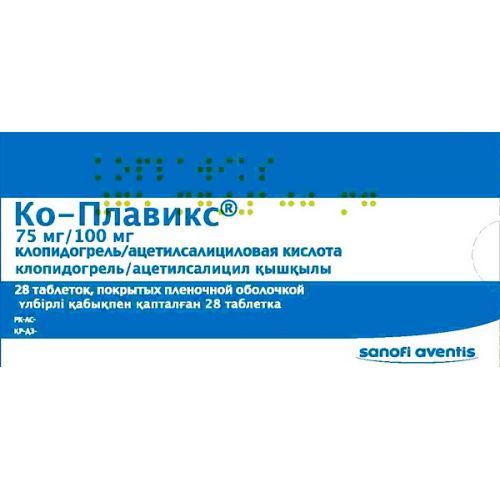
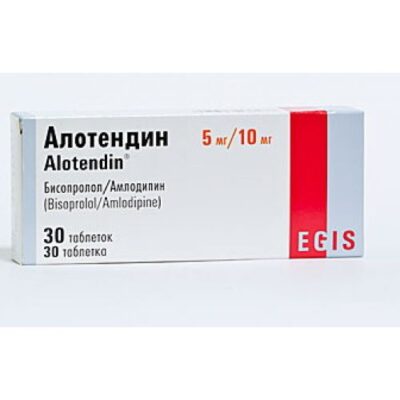
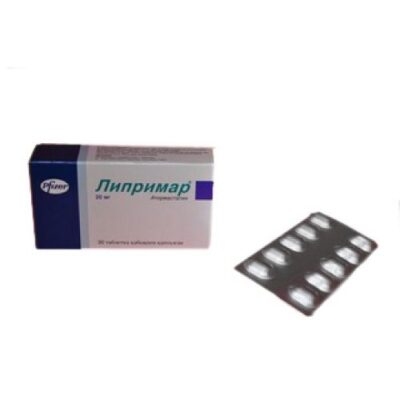
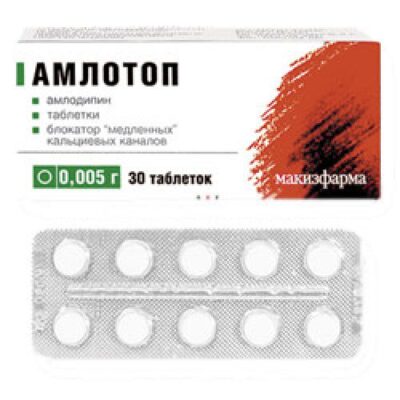
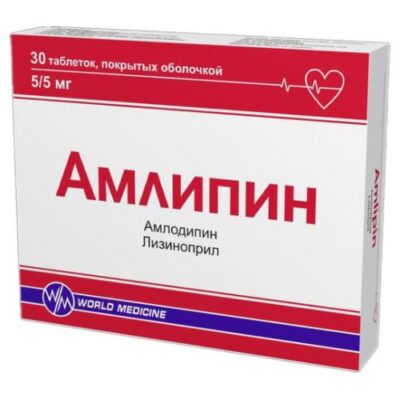
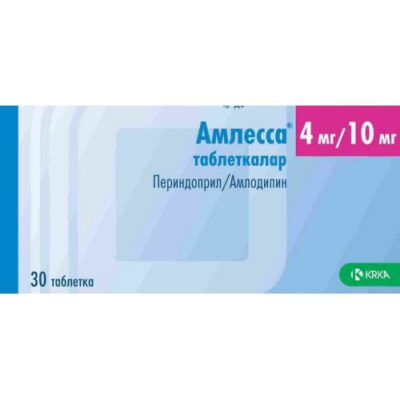
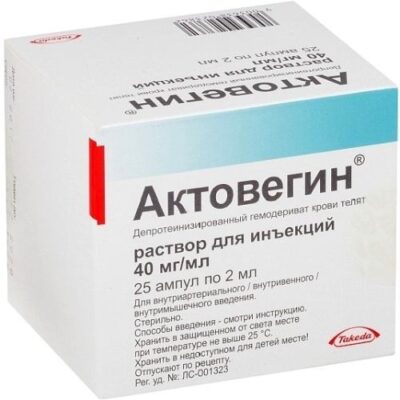
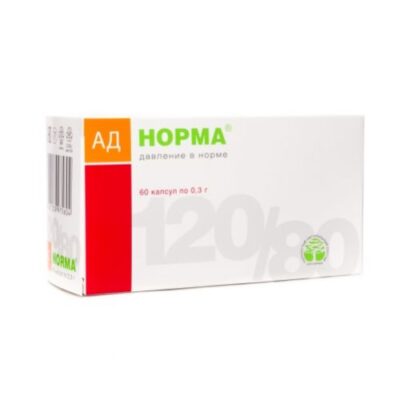
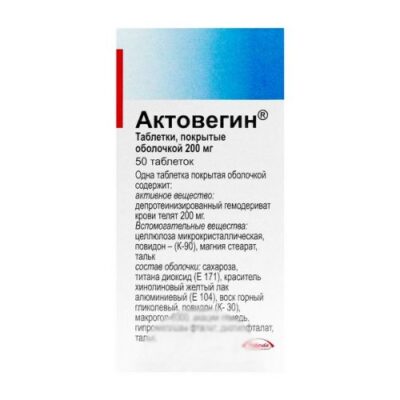
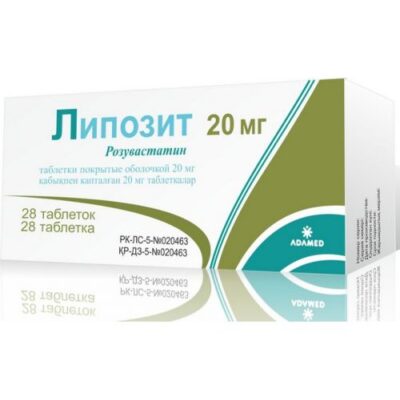
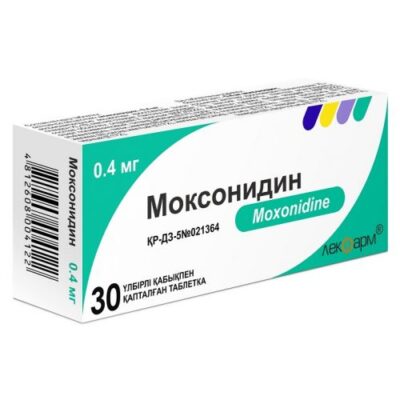






Reviews
There are no reviews yet.